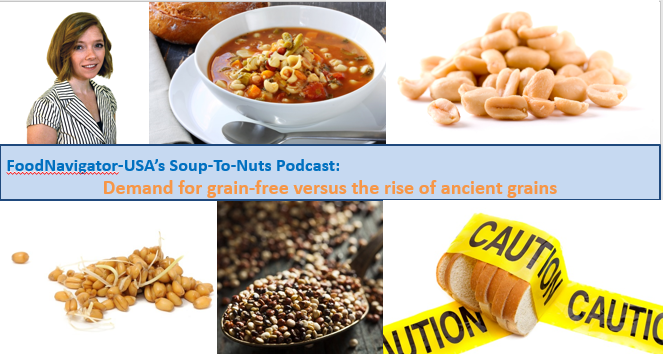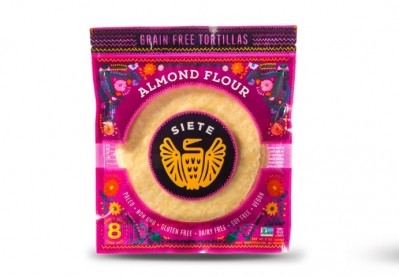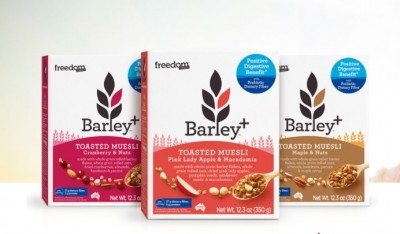Soup-To-Nuts Podcast: Gluten free movement spawns divergent grain-free vs ancient grain trends

The first trend is the rise of grain-free foods – which stems directly from the gluten-free and paleo movements – and which some industry insiders suspect could become even bigger than the gluten free movement.
Evidence of the grain-free movement’s potential is reflected in the 134% increase in the launch of bakery products made with non-grain flours that Mintel uncovered between 2010 and 2014. It also is apparent at recent trade shows where industry newcomers showcased a plethora of grain-free products from granola to tortillas to cookies, crackers and even baking mixes.
The other major trend that is emerging out of the gluten-free movement is the rise of ancient grains. Many of these grains, including millet, quinoa, amaranth, sorghum and teff, all of which are nutritional powerhouses that, according to the Whole Grains Council, also are fueling sales and new product launches.
To learn more about what is fueling these two diverging trends as well as their full marketing potential I caught up with two leaders in each category – Katlin Smith, the founder of clean food company Simple Mills, and Veronica Bosgraff, the founder of Pure Organic.
Looking first at the market potential of the grain free trend, Smith said her products, which include baking mixes, cookies and crackers all made with nuts and seeds instead of grains have seen tremendous growth with distribution in 7,000 stores nationwide in the 3.5 years Simple Mills has been in business.
Smith attributes the success of Simple Mills and the grain-free movement to growing consumer awareness about the impact on their health of what they eat.
“More and more consumers are associating their gut health with their mental and physical wellness. So, people no longer just eat to fill their stomachs, but they think about the role that food can have in their ability to focus or whether they have anxiety and depression or whether they have joint pain or autoimmune disease,” said Smith, who turned to grain free as a way to manager her own wellness.
She explained that people are looking at grains in particular because they can be very irritating due to phytic acid in them, which Smith described as an “anti-nutrient” that binds to nutrients so they are not absorbed in the body. She also says lectins in grains can inhibit the gut’s ability to heal itself.
The case for grains
Whether grains are detrimental to gut health for people in general is at the center of many emotional and contentious debates. According to Oldways Whole Grain Council cutting out grains completely increases the risk consumers could diminish their microbiome diversity. A spokeswoman explained that whole grains are shown to play an important role in promoting the diversity of beneficial bacteria.
She also noted whole grains have played a beneficial role in diets around the world for thousands of years and that by eliminating an entire food group, individuals risk missing out on some of the health benefits of a more comprehensive diet.
The market potential for grain-free
Whether or not grains provide benefits or health risks, the grain-free foods movement holds significant marketing potential and more companies are entering the space.
“There are a number of different players who are starting to play in the grain free space, but I think we are trying to solve for the same problem. There is just a whole sea of product categories out there that traditionally have contained grains and so we actually are pretty friendly with the other grain-free brands,” such as Primal Kitchen, Mikey’s Muffins, Siete and Wildway, she said.
As implied by Smith’s all-for-one and one-for-all attitude towards the competition, there is clearly sufficient white space and room for innovation in the grain-free segment. Smith says the industry is currently focused on making grain-free alternatives to basic staples, such as crackers, cookies, baked goods and other foods that most American’s can’t live without. But as illustrated by the tough early days of the gluten free movement, companies can’t simply swap out the grains – they need to make thoughtful and delicious products that consumers actually want to eat.
Looking forward, Smith says the grain-free movement will continue to grow and will gain a boost from the clean-label trend, which shares many of the same values. She also believes it will tie in with the trend towards gut-friendly products and those aimed at boosting immune health.
The rise of ancient grains
The other major trend that the gluten-free movement has spawned is a resurgence in the use of ancient grains – which is a full 180 degrees in the opposite direction of the grain-free movement.
Only a few grains, such as wheat, rye and barley have gluten – leaving many alternative and so-called ancient grains as options for gluten-free product manufacturers who want the texture and nutritional benefits grains provide.
Gluten-free snack company Pure Organic is one such manufacturer that uses ancient grains in its products. Founder Veronica Bosgraff explained why consumers who do not have celiac disease may still benefit from gluten free products and how ancient grains fit into the equation.
“There is also a growing number of people who are sensitive to highly processed gluten but may not be as sensitive or sensitive at all to whole, organic, clean grains,” including ancient grains that are not overly processed, she said.
This open mind allowed Bosgraff to create a new line of snack bars with ancient grains, which she says are “wonderful.”
Reflecting on the nutritional profile of her company’s overall portfolio, Bosgraff said she decided to make a line of bars with ancient grains because they allowed her to use less sugar, cut calories and offer a totally different texture experience from her date and nut bars.
“I am much more of an advocate for whole, real, simple, organic food. I think that in my book is the most important, and I don’t shy away from any grains if they are whole, real grains and I always look for the most nutrient dense” options, which often are ancient grains, she said.
Even though Bosgraff embraces ancient grains and Smith does not, Bosgraff echoed Smith’s sentiments that clean, whole ingredients are the future.
“As a whole, the population is moving to more simple, recognizable, whole ingredients and that is becoming more important than a label or a certification even. To some degree, they want food made with kitchen cupboard ingredients and that is what as a company we recognize and we have always strive to do,” she said.





















